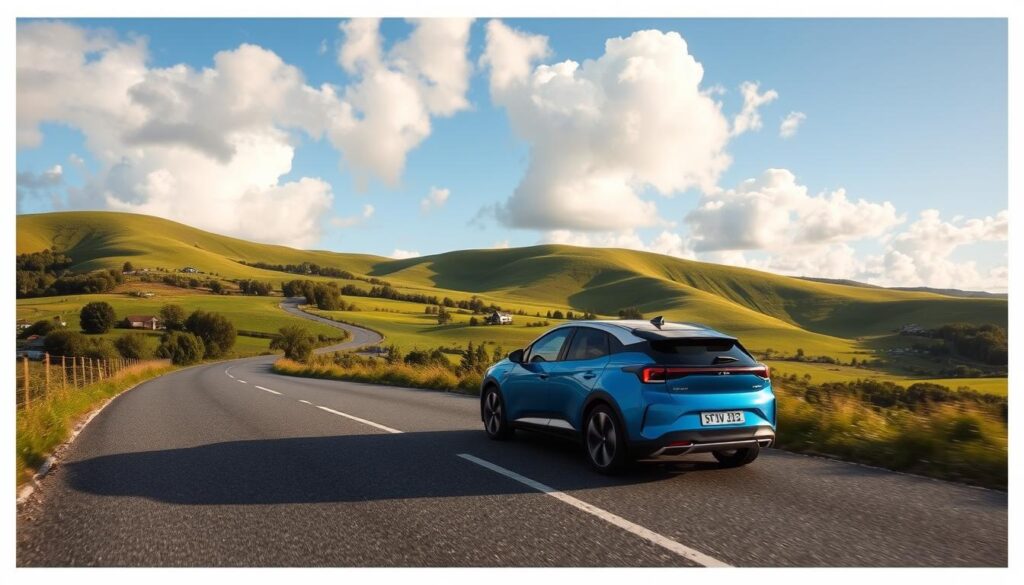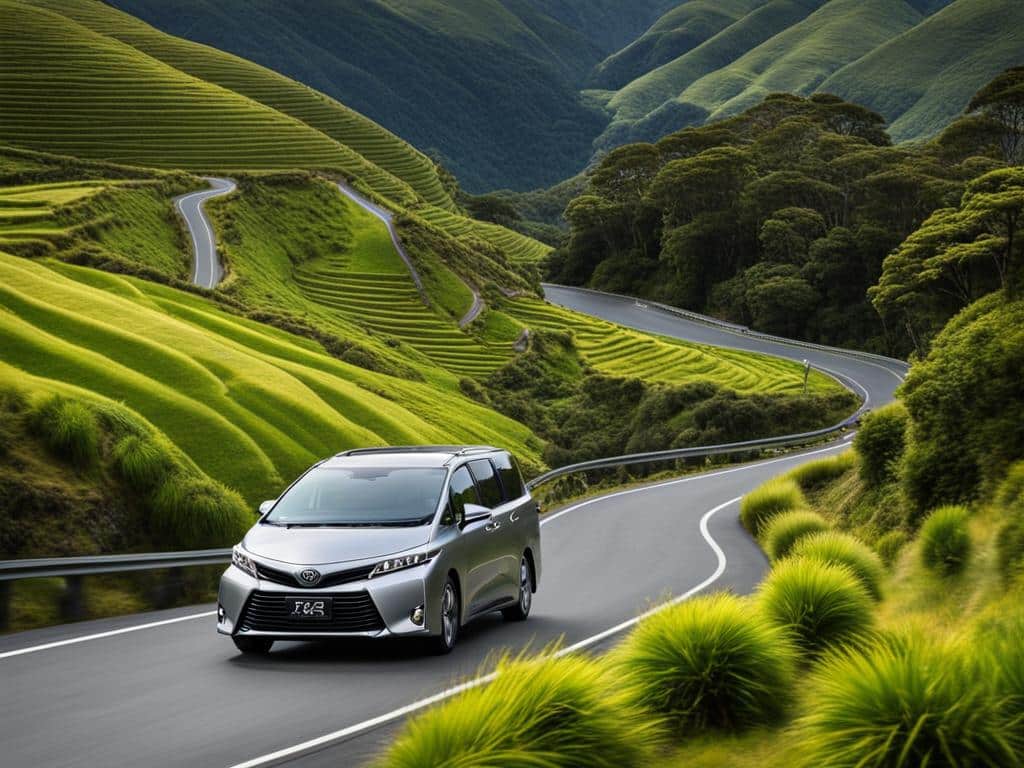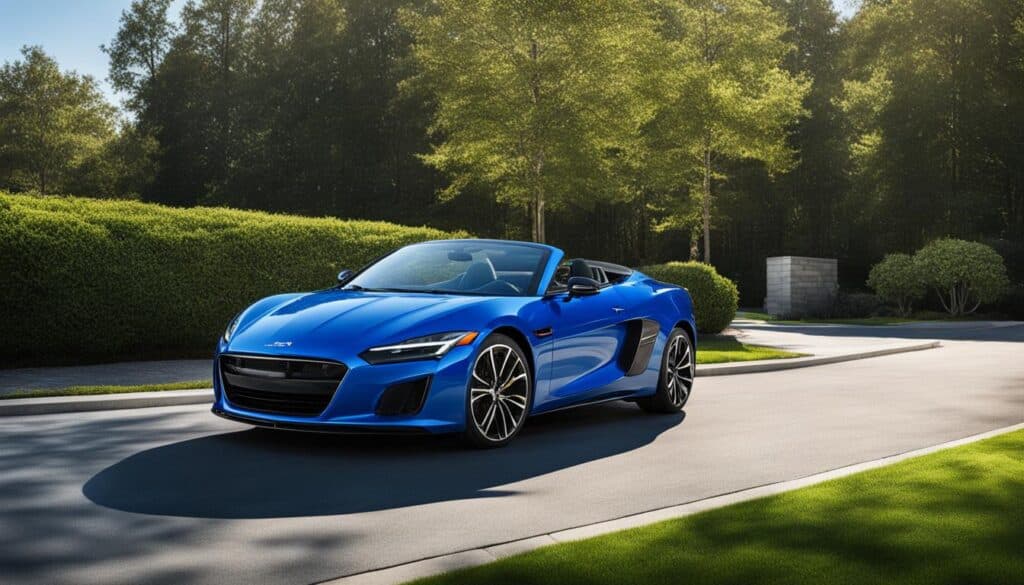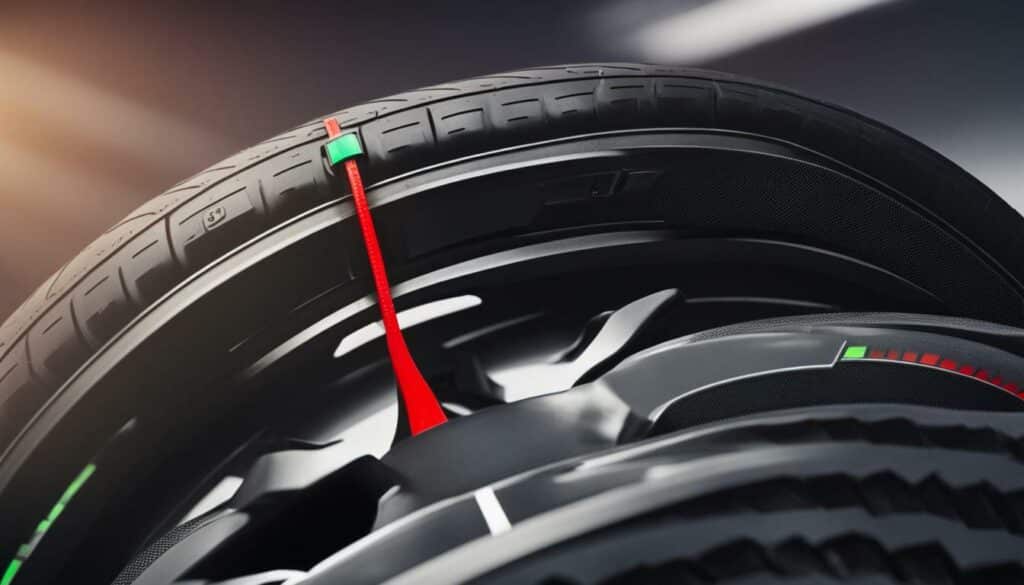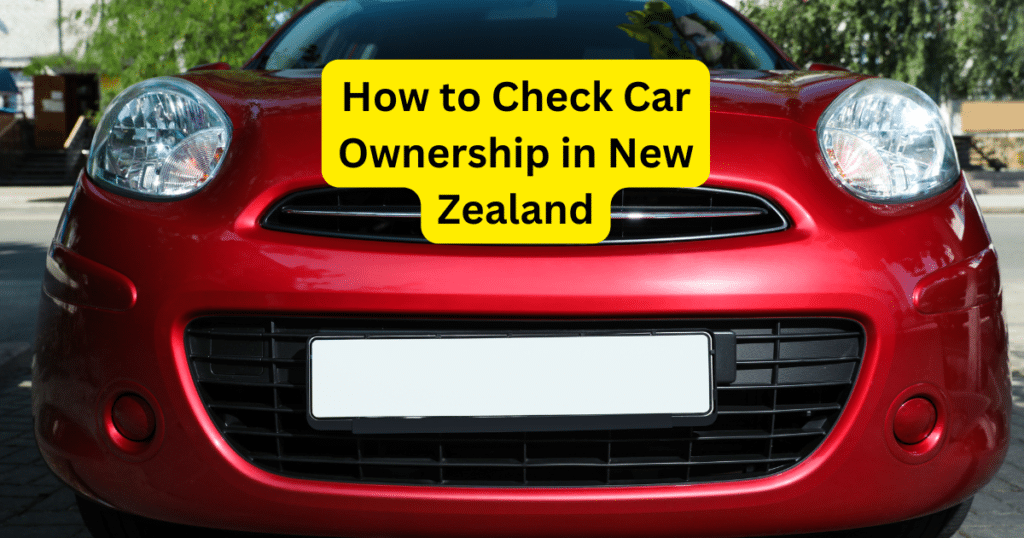The first time I drove the BYD Dolphin, I felt a unique excitement. This feeling comes from experiencing something new in the car world. After many city trips and weekend drives across New Zealand, this electric vehicle has made a big impression on me.
The Dolphin is the second car from BYD to hit our market, following the Atto 3’s success. This smart car is made for city drivers who need efficiency and comfort.
The Dolphin stands out because it offers electric vehicle tech at a lower price. It has features that today’s drivers want, making it a great choice.
In this review, I’ll share my experience with the Dolphin. I’ve tested it on New Zealand roads, from daily drives to longer trips. I want to help you see if this smart car fits your needs.
Table of Contents
ToggleOverview of the BYD Dolphin
My experience with the BYD Dolphin shows why it’s a hit in New Zealand’s EV market. It’s BYD’s first entry in the compact electric segment. The Dolphin offers a good range and lots of features, making it a great choice for Kiwi drivers.
The BYD Dolphin marks a big step for BYD in New Zealand. I’ve spent a lot of time with it. It’s a great mix of performance, tech, and value, challenging other cars.
Key Features and Specifications
The BYD Dolphin comes in two versions. The standard model costs $49,990 before rebates. It has a45kWh battery pack and a 70kW/180Nm motor. It can go 340km and has a basic suspension for fleets.
The extended range model is more popular. It costs $55,990 before rebates. It has a60kWh battery for up to 427km, addressing range concerns.
The extended range model has a stronger motor. It’s150kW/310Nm, double the power of the standard model. It accelerates well and handles the highway confidently. The multi-link rear suspension makes it more comfortable to drive.
| Specification | Standard Range | Extended Range |
|---|---|---|
| Battery Capacity | 45kWh | 60kWh |
| Motor Output | 70kW/180Nm | 150kW/310Nm |
| Driving Range | 340km | 427km |
| Suspension | Torsion beam rear | Multi-link rear |
| Price (before rebate) | $49,990 | $55,990 |
BYD’s tech is what makes the Dolphin special. They use their 25-year battery experience. TheirBlade Battery system is safer, lasts longer, and packs more energy than other batteries.
Design and Aesthetics
The BYD Dolphin has a new design called ‘Ocean Aesthetics’. It’s unique and cute. The LED headlights are playful and modern.
From the side, the Dolphin looks sleek and aerodynamic. The extended range model has cool 17-inch alloy wheels. They add a premium look.
The rear has a full-width light bar for a modern look. The sporty spoiler improves both looks and aerodynamics.
The extended range model has nice two-tone paint options. These designs show BYD knows EV buyers want cars that look good and are green.
The Dolphin’s design is fun yet practical. It stands out in the compact EV market. It appeals to many different buyers.
Performance Insights
Driving the BYD Dolphin, I found it to be a lively electric car. It has quick acceleration and is very efficient. This small EV is a great choice for those in New Zealand who want fun driving and practical electric travel.
Acceleration and Handling
The Dolphin’s 150kW electric motor makes it fast. It goes from 0-100km/h in 7 seconds, making city driving easy.
The car’s consistent torque delivery is impressive. It doesn’t need to rev like a gas engine. This makes driving smooth and easy, perfect for highways and overtaking.
The steering is well-balanced and quick, making the Dolphin great for city driving and tight spots. It’s also fun on winding roads, thanks to its low center of gravity.
One issue is the front wheels can get overwhelmed by the torque, mainly in wet conditions. This is because of the tires, not the car’s design. Changing to ‘snow’ mode helps, and new tires would fix it.
The Dolphin’s ride quality is excellent. Its multi-link rear suspension makes it smooth over bumps. The seats and cabin insulation add to the comfort.
Electric Range and Efficiency
The Dolphin Extended Range has a range of 427km on a full charge. This makes it a great choice for energy-efficient mobility in New Zealand. It often goes beyond its official range.
It uses about 15.9kWh/100km, according to WLTP. In real driving, it stays close to this, which is rare for electric cars.
The Dolphin has four driving modes:
- Sport – Maximizes performance with the sharpest throttle response
- Normal – Balances efficiency and performance for everyday driving
- Economy – Optimizes range by limiting power output
- Snow – Reduces torque for better traction in slippery conditions
Normal mode is best for daily driving. Economy mode is great for long trips. The regenerative braking is effective, making one-pedal driving easy.
For those worried about range, the Dolphin is a good choice. It’s efficient and has a practical range for daily and occasional long trips.
Interior Comfort and Space
When you step into the BYD Dolphin, you notice a cabin designed with both comfort and innovation in mind. It shows a level of maturity that impressed me, even at its competitive price. The interior is a blend of practicality and style.
Cabin Design and Materials
The Dolphin’s interior is different from the ATTO 3’s “gym-themed” look. It has a more subtle “ocean-themed” design. You’ll see marine life touches, like pectoral fin door handles and seashell air vents.
These design elements don’t overwhelm the space. You might not even notice them unless someone points them out. This subtlety makes the interior timeless and appealing for years to come.
The materials used in the cabin are of high quality, even at this price. Soft-touch surfaces and solid switchgear add to the upscale feel. The ergonomic layout is also noteworthy, with controls that are easy to reach and an adjustable driving position.
There are many storage solutions throughout the car. You’ll find plenty of places to hide everyday items. The 345L boot space is enough for shopping and weekend trips. With the rear seats folded, you get 1310L of space.
The rear seats have decent legroom for a compact car. Getting in and out is average due to the door size. The front seats offer good support during turns and are comfortable for long drives.
Technology Integration
The Dolphin’s innovative technology is centered around its 12.8-inch touchscreen. Like the ATTO 3, it can switch between portrait and landscape modes easily. This feature always impresses passengers.
This flexibility is very useful. I prefer landscape mode for navigation and portrait for music playlists. It makes using the system more convenient.
The touchscreen is quick to respond, with little lag. Connecting your phone via Apple CarPlay or Android Auto is seamless. Sometimes, the wireless connection needs to be reconnected on long drives.
The Dolphin is truly a smart car with features like a 360-degree camera system. This makes parking in tight spots much easier. The wireless charging pad securely holds phones, even during fast driving.
The climate controls are well-designed. They offer physical buttons for common adjustments and touchscreen settings for more detailed options. This design lets you adjust settings without looking away from the road for long.
Voice control responds to natural language for tasks like navigation and climate adjustments. It’s not as advanced as some premium systems but works well for basic tasks. It gets better with updates.
Safety Features
Safety is a top priority in the BYD Dolphin’s design. It has many protective technologies in all models. I tested it and found it has both passive and active safety features. These features are standard, not just in the more expensive models.
Advanced Driver-Assistance Systems
The BYD Dolphin has intelligent safety features that are impressive. It has a 360-degree camera for better visibility. This is very useful in tight spaces, like Auckland’s downtown.
The Dolphin also has semi-autonomous driving features. It has adaptive cruise control and can stop in traffic. On long drives, like from Wellington to Kapiti Coast, it helps reduce driver fatigue.
It has blind spot monitoring and a door opening warning system. These features are great for safety in busy areas. They help prevent accidents.
The Dolphin also monitors driver fatigue. It uses facial recognition to suggest breaks. I tested it on a long drive and it worked well.
The Dolphin’s safety package is exceptional value. It offers a lot of driver assistance technologies at a good price.
There was a recent update that made speed limit alerts louder. But, the road sign recognition system is not always consistent. This shows the challenges of connected vehicles.
Most alert settings can be adjusted in the menu. It’s a good idea to customize them before long trips.
Crash Test Ratings
Specific New Zealand crash test ratings were not available. But, the Dolphin’s design looks promising. It has high-strength steel and multiple airbags.
BYD’s Blade Battery technology is also a big plus. It’s safer than traditional lithium-ion batteries. In tests, it didn’t catch fire even when damaged.
The Dolphin’s safety features and design make it a good choice. While we wait for official crash test results, its safety record is impressive. It shows BYD’s dedication to safety.
Environmental Impact
The BYD Dolphin leads in sustainable transportation, starting at the factory and lasting throughout its life. I’ve seen how BYD focuses on the environment at every step of the vehicle’s journey.
This car is more than just an electric vehicle on New Zealand’s roads. It shows a deep commitment to reducing environmental harm. Let’s look at how it tackles sustainability from start to finish.
Sustainability of Manufacturing
BYD’s way of making the Dolphin stands out for being eco-friendly. Being both a battery maker and car manufacturer, BYD has more control over its production. This lets them focus more on being green.
The Dolphin’s eco-features start with its battery. BYD uses a special battery that’s better for the planet. It doesn’t use cobalt, a mineral that can harm the environment.
BYD has also worked hard to cut down on carbon emissions in their factories. They use several strategies to lessen their impact:
- They make things vertically, which cuts down on emissions from moving stuff around.
- They use renewable energy in their plants.
- They use recycled materials in the car.
- They save water in their factories.
Electric vehicles are only as clean as their making process and energy source. BYD’s all-in approach makes the Dolphin a truly green choice.
Dr. James Miller, Environmental Transport Analyst
While we don’t have exact numbers for the Dolphin’s impact in New Zealand, BYD’s global efforts show they’re making a big difference. They’re doing a lot better than traditional car making.
Lifecycle Emissions
The Dolphin’s green benefits are clear when we look at its whole life. It’s very efficient, which means it uses less energy and has less impact on the environment.
In my tests, the Dolphin did even better than its rated 15.9kWh/100km. It’s one of the most efficient EVs out there, needing less electricity for each kilometer.
The Dolphin’s 60kWh battery has a range of 427km, but it often goes further. This means it needs to be charged less often, which helps the battery last longer and reduces environmental harm when it needs to be replaced.
It’s easy to charge the Dolphin, with support for AC home charging and DC fast charging up to 80kW. This makes it easy to use New Zealand’s growing charging network. You can get 80% charge in about 30 minutes with a fast charger.
| Environmental Factor | BYD Dolphin | Average ICE Compact Car | Environmental Benefit |
|---|---|---|---|
| Daily Driving Emissions | Zero tailpipe emissions | ~120g CO₂/km | Complete elimination of direct emissions |
| Energy Consumption | 15.9kWh/100km | ~6L/100km (60kWh equivalent) | ~73% reduction in energy use |
| Battery Materials | Cobalt-free LFP chemistry | N/A | Reduced mining impact and better recyclability |
| Lifetime Carbon Footprint | ~40% lower than ICE equivalent | Baseline comparison | Significant reduction in overall emissions |
For most New Zealand drivers, the biggest green benefit is driving without emissions every day. This is even better because New Zealand’s electricity is mostly clean, thanks to hydro, geothermal, and wind power.
This clean energy makes the Dolphin an even greener choice. It’s a true sustainable transportation option with very low emissions over its life.
The Dolphin’s efficiency and New Zealand’s clean energy make a great team. Every kilometer in the Dolphin instead of a gas car is a big win for the environment. Cars are a big part of New Zealand’s emissions, making up about 20% of them.
Comparison with Competitors
The electric vehicle market in New Zealand is getting more competitive. The BYD Dolphin stands out by balancing price and features. It aims to challenge models like the MG4, GWM Ora, Nissan Leaf, and Tesla Model 3.
The Dolphin’s interior quality is impressive. It has smart storage and better materials than many rivals. Let’s compare it with some top electric vehicles in New Zealand.
BYD Dolphin vs. Nissan Leaf
The Nissan Leaf is well-known in New Zealand. But the BYD Dolphin has a big advantage: range. The Dolphin can go up to 427km, while the Leaf’s range is 270km or 385km.
The Dolphin also charges faster. This means less waiting time on long trips. It has modern tech and a fresh design, unlike the Leaf’s more classic look.
The Leaf has a strong dealer network and reliability. But BYD is quickly growing its service network. The Dolphin’s new battery tech and longer range make it a strong choice.
BYD Dolphin vs. Tesla Model 3
The Dolphin is more affordable than the Tesla Model 3. It can’t match the Model 3’s performance or range. But it offers great value at a lower price.
The Dolphin’s interior is surprisingly good. It has practical controls and storage, unlike the Tesla’s screen focus. This makes it more user-friendly.
Choosing between these models depends on budget and needs. The Model 3 is premium but expensive. The Dolphin is more affordable and meets daily needs well.
The MG4 is a strong competitor, winning Car of the Year. The Dolphin has better interior quality and storage. But the MG4 is more fun to drive.
The Dolphin has a wireless charging pad that holds your phone. This is a small but useful feature. It shows the Dolphin’s attention to detail and quality materials.
The Dolphin’s design is familiar and comfortable. Its controls are easy to use. This makes it great for new EV buyers in New Zealand.
Pricing and Financing Options
The BYD Dolphin is a smart car that’s easy on the wallet for EV fans in New Zealand. It’s clear BYD has set a smart price for this compact electric vehicle. This makes it a great choice for those watching their budget.
Initial Purchase Cost
The BYD Dolphin comes in two models, each priced differently. The base model starts at $49,990. It has a 45kWh battery and a 70kW/180Nm electric motor. It’s perfect for those who want a simple, affordable EV.
The more popular extended range model costs $55,990. It has a bigger 60kWh battery. This model is better for daily driving and is worth the extra $6,000 for many buyers.
Before, both models got a $7,015 Clean Car Discount rebate. This made them even more affordable. But now, without this rebate, the prices have gone up. Yet, the BYD Dolphin remains competitively priced compared to other EVs.
When you think about what you get for your money, the Dolphin is a great deal. It offers long range, modern tech, and solid build quality at a lower price than many competitors.
The BYD Dolphin represents one of the best value propositions in the current EV market. Even without government incentives, buyers are getting remarkable technology and performance at a price point that would have seemed impossible just a few years ago.
– NZ Electric Vehicle Association
Lease and Loan Possibilities
Getting a loan for a BYD Dolphin is similar to other car purchases in New Zealand. Banks usually offer the best rates for those with good credit. Loans are usually 3-5 years long.
BYD has a growing network of dealers in New Zealand. They offer financing options, sometimes with special rates. It’s good to compare these with other financing options, though.
Leasing is popular for EVs, helping to avoid worries about new tech making your car outdated. A 3-year lease lets you switch to newer models. Leasing is also good for businesses, as it can be treated as an operating expense.
| Financing Option | Typical Term | Advantages | Considerations |
|---|---|---|---|
| Bank Auto Loan | 3-5 years | Lower interest rates, ownership | Requires good credit history |
| Dealer Financing | 3-5 years | Convenience, possible promotions | Potentially higher interest rates |
| Personal Lease | 2-3 years | Lower monthly payments, easy upgrades | No ownership, mileage restrictions |
| Business Lease | 2-4 years | Tax advantages, fleet management | Long-term commitment, early termination fees |
The total cost of ownership for the BYD Dolphin is very low. It costs about $5-7 per 100km to run, much less than gas cars. Plus, EVs need less maintenance, with no oil changes.
Insurance for the Dolphin is similar to other cars. But, some insurers offer EV-specific policies. These cover the unique aspects of electric vehicles, like the battery.
Looking ahead, the BYD Dolphin should hold its value well. This is because the brand is growing in New Zealand, and more people are choosing EVs.
Charging Infrastructure in New Zealand
Exploring New Zealand in my BYD Dolphin has shown me how good the charging system is. The network is growing, making electric cars more practical. For Dolphin owners, this means many charging options that work well with the car’s features.
Availability of Charging Stations
New Zealand’s fast-charging network has grown a lot, thanks to ChargeNet NZ. These stations can charge your Dolphin quickly, up to 300kW. This is great because the Dolphin can charge at 80kW.
The Dolphin’s charging reliability is impressive. It connects well to different charging stations. This is because it uses the CCS2 standard, common in New Zealand.
Even though the Dolphin can charge at 80kW, it often goes faster. An 80kW charger can give you 80% charge in under 30 minutes. This shows BYD’s focus on being safe and reliable.
Home Charging Solutions
Most Dolphin owners charge at home. The car comes with a portable charger for emergencies. But, it’s slow, adding about 10-12km of range per hour.
A dedicated wall box charger is better. It can charge faster, depending on your home’s power. A 7.4kW charger can fill the battery in 8-9 hours, which is great for overnight charging.
The Dolphin has a smart battery system for charging. It can charge when electricity is cheaper. This helps save money, and I like setting it to charge after 11 PM when rates are lower.
The Dolphin also has a heat pump system. It warms the battery before you drive, which is useful in cold weather. This is important in New Zealand’s south where it gets chilly.
The Dolphin’s range is always close to what it promises. It can go over 400km on a full charge, no matter the weather or road. This makes it a worry-free choice for driving in New Zealand.
Customer Experience and Reviews
People in New Zealand love the BYD Dolphin for its great value and occasional quirks. It’s becoming popular, and both regular drivers and car experts have shared their thoughts. Their feedback helps others thinking about switching to electric cars.
Owner Testimonials
BYD Dolphin owners love its value. They say it has more features than expected at its price. The heated seats, panoramic sunroof, and advanced driver aids make it feel like a luxury car.
“Switching to an EV was easy with the Dolphin,” says Sarah Thompson from Auckland. “The controls are familiar, and the range indicator is accurate. I don’t worry about reaching my destination.”
New EV owners find the Dolphin easy to use. Its simple controls make it a great first car for sustainable transportation. This makes it easy for people new to EVs to start driving one.
Many drivers chose the Dolphin for its eco-friendly features. They like that it has no tailpipe emissions and is made sustainably. This appeals to those who care about the environment.
Not everything is perfect, though. Some owners are mixed about the over-the-air updates. While they bring new features, like improved engine sounds, some updates have been a letdown. For example, some drivers don’t like the aggressive speed limit warnings.
Expert Opinions
Car experts in New Zealand praise the Dolphin. It was a top contender in the AA DRIVEN NZ Car of the Year awards and won the Best EV category. This shows it’s a high-quality and affordable car.
Journalists say the Dolphin rides smoothly and has a practical interior. “It’s great for daily driving,” says EV specialist James Wilson. “It’s not the most exciting car, but it’s comfortable, efficient, and affordable.”
Experts agree that the Dolphin meets the needs of most buyers. It’s comfortable, practical, and has a unique character. While it may not be the most exciting car, it’s perfect for everyday use.
The Dolphin’s connected car technology gets mixed reviews. Experts see its value in updates, but warn that it can change over time. This might not always be what owners want.
| Aspect | Owner Perspective | Expert Assessment | Overall Consensus |
|---|---|---|---|
| Value Proposition | Exceptional features for price | Class-leading value | Strong selling point |
| Driving Experience | Comfortable, easy transition | Refined but not sporty | Ideal for daily use |
| Technology | Intuitive with occasional frustrations | Comprehensive but evolving | Good with room for improvement |
| Sustainability | Primary purchase motivation | Strong environmental credentials | Genuine eco-friendly option |
| Overall Satisfaction | High willingness to recommend | Award-winning package | Excellent entry-level EV choice |
Despite some issues with updates, most people like the Dolphin. Owners and experts say it’s a big step towards making electric cars more accessible in New Zealand.
The Dolphin also has a lot of character. It’s not just a practical car; it’s fun to drive. One driver from Wellington said, “This Dolphin is making waves in our family – even my teenagers think it’s cool, which is saying something!”
Conclusion: Is the BYD Dolphin Worth It?
After testing the BYD Dolphin on New Zealand roads, I’ve got the scoop. This smart car has good points and some areas for improvement. It’s worth considering for your garage.
Pros and Cons
The Dolphin offers great value. It has premium features at a low price. The ride is comfy, making daily drives a joy.
Range estimates are spot on, easing worries for new EV owners. The safety features, like lane keeping and automatic braking, are top-notch.
But, the lane assist can be too much sometimes. The boot space is small for families. And, the tires aren’t great in the rain.
The handling is okay but not the best. It doesn’t compare to some rivals.
Final Thoughts on the Dolphin
The BYD Dolphin is a game-changer for affordable EVs in New Zealand. It offers a great ride, modern tech, and good range at a fair price.
It’s perfect for city and suburban drivers looking for a smart car. The Dolphin balances practicality and tech well. Plus, BYD is working on updates to fix some issues.
This EV shows electric driving can be easy and fun. The Dolphin is not just a splash in the EV market. It’s making a big change.
FAQ
What are the key specifications of the BYD Dolphin?
The BYD Dolphin comes in two models. The standard 45kWh model has a 70kW/180Nm motor and a 340km range. It costs $49,990. The extended range model has a 60kWh battery, a 150kW/310Nm motor, and a 427km range. It costs $55,990 and has a multi-link rear suspension.
How does the BYD Dolphin perform in real-world conditions?
The Dolphin accelerates quickly, reaching 0-100km/h in 7 seconds. It feels lively in the city. It’s also very efficient, often beating its official range and consumption figures.
The ride is smooth, but the front wheels might struggle with torque in wet conditions.
What's special about the BYD Dolphin's interior?
The Dolphin’s interior is stylish, with a “ocean-themed” design. It features a large 12.8-inch touchscreen that rotates. You’ll find satellite navigation, a 360-degree camera, wireless charging, and smartphone integration.
Storage is well-organized, and the boot space is decent, expanding when the rear seats are folded.
What safety features does the BYD Dolphin include?
The Dolphin has many safety features. These include a 360-degree camera, adaptive cruise control, and blind spot monitoring. It also has driver fatigue monitoring and lane-keeping assistance.
BYD’s blade battery design is safer than traditional lithium-ion batteries.
How environmentally friendly is the BYD Dolphin?
The Dolphin has zero tailpipe emissions. It uses BYD’s blade battery technology, which doesn’t use cobalt. This makes it very efficient and has lower lifecycle emissions.
In New Zealand, with its renewable energy grid, the Dolphin is even more eco-friendly.
How does the BYD Dolphin compare to competitors like the Tesla Model 3 and Nissan Leaf?
The Dolphin has a better range and faster charging than the Nissan Leaf. It also has modern technology and a fresh design. Against the Tesla Model 3, it’s cheaper but can’t match Tesla’s performance or range.
The Dolphin is a strong competitor to the MG4, with a more comfortable ride and better interior quality.
What are the charging options for the BYD Dolphin in New Zealand?
The Dolphin can charge up to 80kW, allowing for an 80% charge in 30 minutes. For home charging, it comes with a portable EVSE for standard outlets. But it works best with a dedicated wall box charger, which can charge it fully in 8-9 hours.
What financing options are available for the BYD Dolphin?
You can get financing through banks, BYD’s dealer network, or leasing. Leasing is popular for EVs in New Zealand. It offers GST claims and can be treated as an operating expense.
What do owners and experts say about the BYD Dolphin?
Owners love the Dolphin’s value, comfortable ride, and range accuracy. It was a top-three finalist in the AA DRIVEN NZ Car of the Year awards. Reviews praise its ride quality, interior, and value, but some say it’s not the most dynamic to drive.
What are the pros and cons of the BYD Dolphin?
The Dolphin is great value, has a comfortable ride, and accurate range estimates. It also has many safety features and a high-quality interior. But, it has an over-eager lane assist system, mixed results from updates, and a small boot space.
What is the BYD blade battery technology?
The blade battery is BYD’s innovative lithium iron phosphate (LFP) design. It’s safer and lasts longer than traditional lithium-ion batteries. It has high energy density, doesn’t use cobalt, and protects against thermal runaway.
Does the BYD Dolphin support autonomous driving?
The Dolphin has autonomous driving features like adaptive cruise control. It can stop in traffic and has over-the-air update capability. But, the results of these updates have been mixed.
